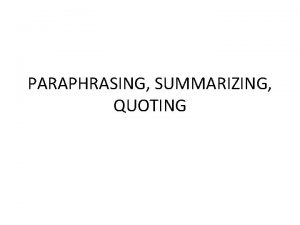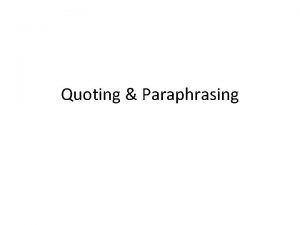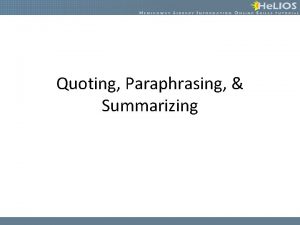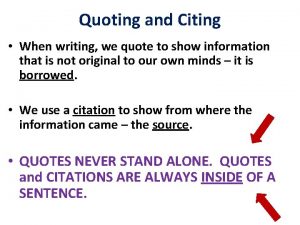Quoting QUOTE WHY Transfer the exact words of












- Slides: 12

Quoting

QUOTE WHY Transfer the exact words of a text and support a point you make in your paper WHAT Something brief and well stated (remember: quotations in a text can be up to 10 -15% of the total number of words) WHEN Emphasize a point HOW By using quotation marks and transferring the exact words of the original text + reference to the source

When to QUOTE • • to show that an authority supports your point to present a position or argument to critique or comment on to include especially moving or historically significant language to present a particularly well-stated extract whose meaning would be lost or changed if paraphrased or summarized

What do we quote? • Something brief and well stated

Here are some famous quotes

INTRODUCING A QUOTE Direct quotations can be introduced in several ways. By using a variety of verbs and sentence patterns, you can incorporate the quotations and ideas smoothly into your text. Each direct quotation or paraphrase should be carefully and thoughtfully synthesized into your writing.

WAYS TO INTRODUCE A QUOTE Examples In a recent article, Smith (2005) comments that… Smith (2005) believes that “…” Similarly, Smith (2005) proposes that the problem becomes… Smith (2005) stipulates that “…” Smith (2005) makes this conclusion, “…” Smith (2005) reports that “…” “…, ” Smith (2005) suggests.

INTRODUCTORY VERBS admit affirm argue believe confirm content declare demand mention observe propose rely reveal see say state show submit summarize think theorize

Short Quotations If you are directly quoting from a work, you will need to include the author, year of publication, and the page number for the reference (preceded by "p. "). Introduce the quotation with a signal phrase that includes the author's last name followed by the date of publication in parentheses.

An example of short quotation • According to Jones (1998), "Students often had difficulty using APA style, especially when it was their first time" (p. 199). • Jones (1998) found "students often had difficulty using APA style" (p. 199). • It has often been argued that “students often had difficulty using APA style, especially when it was their first time" (Jones, 1998, p. 199).

Long Quotations Place direct quotations longer than 40 words in a free-standing block of typewritten lines, and omit quotation marks. Start the quotation on a new line, indented five spaces from the left margin. Type the entire quotation on the new margin, and indent the first line of any subsequent paragraph within the quotation five spaces from the new margin. Maintain double-spacing throughout. The parenthetical citation should come after the closing punctuation mark.

 Hey bye bye
Hey bye bye How to quote a quote apa
How to quote a quote apa Dialogue quote vs flow quote
Dialogue quote vs flow quote Integrate quotes
Integrate quotes Dialogue quote vs flow quote
Dialogue quote vs flow quote Ap style question mark in quotes
Ap style question mark in quotes How to cite multiple authors
How to cite multiple authors How to cite dialogue
How to cite dialogue How to cite shakespeare lines
How to cite shakespeare lines Try to practice paraphrasing summarizing and direct quoting
Try to practice paraphrasing summarizing and direct quoting The second sex mla citation
The second sex mla citation Quoting articles
Quoting articles Apa citation many authors
Apa citation many authors






















